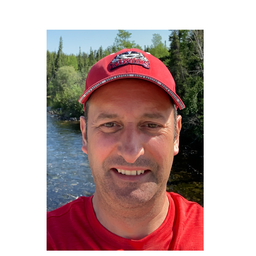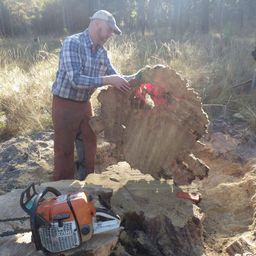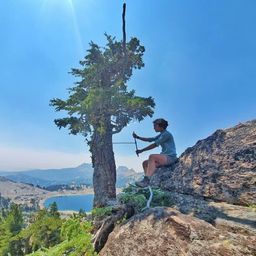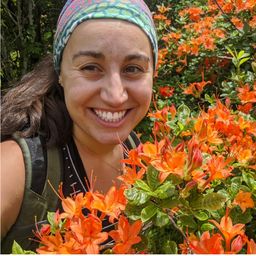Poster Session
My Session Status
Presentation of all Ameridendro2022 posters.
FREE LUNCH FOR ALL ATTENDEES!
Sub Sessions
Water scarcity is a major 21st century challenge that is increasing the vulnerability of the human population, especially in cities. Water risk assessment is a fundamental task in many cities worldwide that often lack long-term and spatially-resolved records of precipitation and level of water reservoirs. Past rainfall and reservoirs levels may be alternatively assessed using tree-ring stable isotopes of urban trees. We assessed the past variability of precipitation and reservoirs level th...
Forest carbon (C) balance projections rely on models describing tree physiological processes to assess forest growth. The representation of C allocation and xylogenesis is still a source of uncertainty in these projections. The objective of this project is to improve boreal C balance projections by including explicitly tree C allocation and wood formation processes in modeling.We will use xylogenesis monitoring data from micro-cores and dendrometers over two gradients. A longitudinal g...
Trait plasticity supports tree growth and survival in multiple environments and is important at the edges of species ranges, with limited tree growth. Xylem anatomical traits determine sap, nutrient flow and mechanical strength. Trait analysis can provide information on species adaptation to extreme climatic conditions. My project studies xylem anatomical traits over the distribution range of the sugar maple in Quebec, where it finds its northern limit. We intend to understand the links be...
Forest management options aimed at mitigating the rate of increase in atmospheric concentrations of CO2, include thinning and partial harvesting to increase growth and carbon (C) capture of residual trees as a stand matures. Variable retention harvesting (VRH) can be used to increase forest growth rates and C sequestration, while enhancing biodiversity and resilience. Across southern Ontario, Canada, numerous plantations were established in the early 20th century on abandoned agricultural ...
Beaver Island, Michigan was occupied by a religious sect led by James J. Strang from 1848-1856. Strang was crowned king of the group, but assassinated by disgruntled followers in 1856, whereupon local fishermen drove the “Strangites” off the island and reportedly took over or destroyed their buildings. Some of the structures from the Strangite period have known construction dates, while details for others are uncertain. We identified the species and cutting dates for logs in eight structur...
The main objective of this project is to quantify the increased productivity of Betula glandulosa Michx in Umiujaq, Nunavik, northern Quebec and evaluate how climatic and edaphic conditions influence this change. The speed at which climate change is affecting the northern ecosystems remains poorly understood and data are needed to anticipate future ecological and physiological trajectories of the vegetation. We produced a tree-ring chronology from approximately 40 specimens of Betula gland...
We reconstructed wildfire history from fire-scars to detect the influences of climatic variability and land-use change on wildfire dynamics in the lodgepole pine (Pinus contorta var. latifolia Engelm.) forests of Jasper National Park in the Canadian Rocky Mountains. New original analyses were performed on 170 cross-section samples collected in the 1970s from 52 sites around Jasper, Alberta. The updated fire record reveals that fire occurrence was highly variable: site-lev...
The Tiger Creek Preserve in central Florida has one of the highest concentrations of threatened and endangered plants and animals in the United States. Historically it was probably a longleaf pine savanna, but fire exclusion in recent decades has almost certainly led to increased basal area by mid-story oaks (mainly Quercus geminata and Q. laevis). Determining the date of establishment of these trees, as well as the early fire history of the site, would provide evidence to supp...
Despite their potential benefits, streamflow reconstructions from tree-rings have not been widely used in water systems analysis because the flow is generally constructed at annual resolution, which may be too coarse for analysis of drought/flood vulnerability and decision making. In semi-arid regions of Chile there are very good relationships between these daily and annual flow, which is explained because within these regions, few hydrological events within a year explain most of the annu...
Increasing frequency of droughts strongly affect the available soil water. Lower water availability was often reported to reduce radial growth not only in climate-limited, but also in optimal areas of tree species distribution. Sampling strategies in dendrochronology focus on specific sites, often in climate-limited conditions. Using tree ring samples collected within National Forest Inventories provides an opportunity to assess growth-climate responses statistically representative o...
In eastern boreal Canada, in the absence of long gauge records, changes in tree-ring anatomy of periodically flooded trees have allowed reconstruction of spring floods in natural rivers. This study analyzes the effect of regulation on the flood rings (FR) occurrence and on ring widths in Fraxinus nigra trees growing at 5 sites distributed along the Driftwood River floodplain to determine if a flood reconstruction using FR could be done in regulated rivers. Driftwood River was regulated by ...
Hydroclimate variability in tropical South America is strongly regulated by the South American Summer Monsoon (SASM). However, past precipitation changes are poorly constrained due to limited observations and high-resolution paleoproxies. We found that summer precipitation and the El Niño-Southern Oscillation tarapacana (ENSO) in the Chilean variability and Bolivian are well registered Altiplano in in tree-ring the Central stable Andes oxygen (18–22°S, isotopes ∼4,500 (δ18OTR) m a.s.l.) of...
Trees do not grow during winter where freezing temperatures occur regularly. Therefore, much of what has been learned from tree-ring data about variability in Earth’s climate is driven by summer conditions. To investigate winter climate and atmospheric circulation over North America, we employ a multi-proxy approach. First, we use earlywood carbon and oxygen stable isotopes of trees growing adjacent to Lake Superior to capture the climate memory embodied by this inland sea. Indeed, previou...
The use of stable isotope proxies in combination with tree-ring parameters has become a well-established tool to unravel plants’ responses to a changing environment. However, while there have been many studies on intra-annual wood formation processes, the specific details of the fractionation of stable isotopes in high-resolution time scales -knowing the exact date of fractionation- remain unknown. Such a time scale mismatch, provides obstacles to investigate the timing, sensitivity and in...
Stable carbon (δ13Cc) and oxygen (δ18Oc) isotopes in tree-ring cellulose, and tree-ring width (TRW), have been used extensively to investigate the effects of climate on tree growth. By contrast, the information recorded by the non-exchangeable carbon-bound hydrogen (δ2Hc) isotopes, has been far less explored. To create a comprehensive assessment of δ2H potential as a proxy for climate, hydrology, plant metabolism, and physiology we explored its relationships with climate an...
Here we report shrub-ring isotope records for big sagebrush (Artemisia tridentata) from below the “reverse treeline” in central Utah, USA. Despite sectorial growth, ring-widths of mature plants (age range 9 to 54 years) cross-dated well. Plants were sampled in upland locations (controls) as well as adjacent to mounds (circular patches of denuded soil approximately five m diameter) made by harvester ants (Pogonomyrmex occidentalis) and in swale locations where water drains during monsoon ra...
Long-term streamflow records are essential for water resources management in semi-arid regions. However, the shortness of instrumental records in Iran and the limited availability of the regional paleoclimate proxies to extend these records back in time hinder our understanding of hydrologic variability. Here, we used the annually resolved tree-ring chronologies from neighboring countries to present the first multi-centennial (~500 years) streamflow reconstruction for the Dez catchment, so...
In the last few decades, natural disturbances and human activities intensified the negative impact on the forest cover on a global scale. The impact of climate change on species distribution and structure, population dynamics, and growing conditions are more prominent now than ever before. To understand the impact of these extreme climate events on the forests, the tree growth resilience approach has been u...
Fire-dependent red pine (Pinus resinosa Ait.) vegetation communities in the central Appalac...
To determine how trees of a temperate to boreal ecotone forest have responded to climate change and nitrogen deposition we investigated tree-ring growth and stable carbon isotope responses of sugar maple and white spruce at Turkey Lakes Watershed (TLW), in Ontario, Canada. Trees at TLW underwent a dramatic surge in age-adjusted tree basal area increment (ΔBAI) between 1900 and 1970 and have declined thereafter. The early ΔBAI pulse was acutely expressed in sugar maples and white spruce whe...
Oxygen isotope ratios in tree rings (δ18OTR) from Amazon forests have been shown to provide historical records of rainfall amounts at a large scale, due to the rainout of heavy isotopes during moisture transport. Here, we present a 110-year oxygen isotope record obtained from tree ring-cellulose of six Cedrela odorata trees (rbar = 0.57, EPS = 0.89) from the region of Tapajos River, Eastern Amazon. Our analysis indicates that δ18OTR series reflects inter-annual variability of wet season (J...
Soil moisture (SM) is a crucial variable to the energy balance between the soil and the atmosphere. Given the lack of long-term instrumental SM measurements, information captured by satellites and climate reanalysis emerges as a useful tool. In the Mediterranean ecosystems of Chile (MC; 30°-36°S), several studies have reported a forest decline mainly associated with a persistent mega-drought (MD) during the last decade. We evaluated the main spatio-temporal patterns of tree growth during 1...
The classic definition of the so-called “divergence problem” is a decoupling of temperature sensitive tree-ring chronologies from the instrumental record – expressed either as a loss or weakening in the inter-annual signal, or a divergence in trend in the recent period. Western Canada is one such area where divergence is ostensibly prevalent. However, recent observations using ring-width (RW) and latewood blue intensity (LWB) parameters challenge our views on divergence in this region: tre...
Anthropogenic climate warming is altering the ecosystem function of temperate and boreal forests. A number of studies have indicated a rise in overall ecological productivity due to a lengthening growing season, particularly into early spring. However, interactions between temperature and precipitation remain understudied with respect to their combined impacts on the responses of trees to warming in spring. Here, I examine the sensitivity of common Midwestern conifers to multiple dimension...
"Multi-centennial to millennial-long oak ring width chronologies from living and relict wood are frequently used for climate reconstructions, but the amount of explained hydroclimatic variation remains relatively small. Although stable carbon and oxygen isotopic ratios (δ13C and δ18O values) in tree rings may offer enhanced climate sensitivity, our understanding of their paleoclimatic sensitivity is still limited by the general lack of well-replicated and high-resolution datasets. Here, we...
To estimate the effects of a warmer and drier future climate on mountain forests, we analyzed the climate response of radial growth of five different conifer species along elevation transects between 1070 m and the forest line near 2400 m above sea level within an inner-alpine dry valley in the LTSER area Matsch|Mazia in Northern Italy. For additional information in growth processes and tree hydraulics automatic dendrometer measurements were used. As expected, we generally observed positiv...
Spatially-resolved climate field reconstructions are ideal for analyzing spatial anomaly patterns and characterizing regional-scale trends resultant from climate change. To date, few fine-scale, spatially-resolved paleotemperature datasets exist in the Northern Hemisphere. Here, we present a 2.5x2.5o temperature field reconstruction of warm season (April-August) mean surface air temperatures, developed from a network of 130 tree-ring chronologies. In the reconstruction’s current form, stat...
Central Europe has been affected by unprecedented summer droughts in the 21st century, resulting in large-scale forest decline that has impacted many native tree species. Growth analyses of multiple tree species from mid to low elevation in Europe remain sparse, despite decades of dendroclimatological studies, and limit our understanding of how forests will evolve under changing climate conditions. Here, we introduce a new multi-species tree-ring width network of 65 individual sites (>2...
Dendroclimatology in the tropical forest regions has lagged behind the more temperate forested regions of the world because of the challenge of determining annual ring formation. Despite over 230 tropical tree species known to form annual rings, the ITRDB shows few published chronologies in tropical forests in Sub-Saharan Africa. As part of the first “Training in Tree-Ring Science and its Applications” workshop conducted in Kitwe, Zambia, our team explored the dendroclimatic potential of B...
The objective of this study is to verify if stable isotopes (C, O) and growth series retrieved from black spruce trees (Picea mariana) growing on boreal lakeshores (riparians trees) show similar variations to those growing away from the shores (non-riparian trees). In NE Canada, riparian trees are particularly interesting because they eventually become lake subfossils, which form the main archives of hydro-climate conditions. However, the extent to which those riparian trees, growing in ol...
Photosynthesis and tree-growth are interconnected processes that are independently modulated by environmental variables. The lack of co-located high spatiotemporal resolution measurements of photosynthesis and growth has limited our understanding of their relationship with each other and their environment. Here, we study photosynthesis and tree-growth at near-instantaneous timescales using in-situ and satellite remote-remote sensing, point dendrometers, quantitative wood anatomy, and Pulse...
Treeline migration on account of climate change have been reported from various forest ecosystem of the world. The Himalaya are no exception to this. Meteorological records from the western Himalaya, show increasing trend in mean annual temperature in the last century with rapid winter warming. The forest vegetation at the ecotone zone are sensitive to changes in climate variability having profound effects on species composition and diversity, recruitment pattern and altitudinal shifts. We...
Western Ukraine are largely forested, especially Transcarpatia with more than 50% of the land covered by forests. Despite this fact, Transcarpathian Ukraine belongs to the last European regions without a long and well replicated oak TRW chronology. The first step in compiling a new tree-ring width (TRW) chronology is to start with living trees; therefore, a new recent oak TRW chronology was assembled.In this study, totally 336 oak samples from 16 oak forest stands and 1 sawmill from th...
The Miombo woodlands of interior Africa are fire adapted ecosystems with a relatively open canopy dominated by Brachystegia spp., Julbernardia spp., and Isoberlina spp. These ecosystems are threatened due to deforestation, habitat fragmentation, and impacts from climate change, and in Zambia, they are further threatened by the rapidly growing mining industry which contributes to air pollution, contamination of soils and water, and land degradation. In this study, we used modified variable ...
It has been shown that trees get older in the wet tropics, but the mechanisms behind this observation are still not clear. Literature shows that moisture could directly affect longevity by modulating physiological processes of trees. Other studies point to the potential role of water on tree size, which could indirectly affect longevity if one reconciles to the fact that the growth rate of tropical trees doesn’t differ significantly between wet and dry sites. The third group points to the ...
As climate change continues at a rapid pace, compounding ecosystem disturbances are becoming an issue of global concern. The limits within which ecosystems operate are likely to be altered by catalytic, or compounding, disturbances, threatening their resilience. Positioned in the heart of the western US, the Greater Yellowstone ecosystem (GYE) is a well-studied and large wildland region dominated by conifer forests characterized by an infrequent, high-severity fire regime with return inter...
Recent studies have shown that long-lived tropical trees are able to recover from senescence stages and maintain high rates of aboveground carbon and biomass accumulation throughout their life span. In this study, we present a tree-ring-based analysis to estimate the annual accumulation of aboveground biomass (AGB) and carbon (C-accumulation) of an Ocotea porosa tree over the last five centuries (1485–2016). The study site is located in southern Brazil, under a subtropical climate. AGB was...
Continuous cover forestry (CCF) has been promoted as an environmentally sustainable option for drained peatlands. The CCF management has also been challenged due to potential lower tree growth compared to traditional even-aged management, especially with suppressed trees that are released during thinning.Our objective was to quantify the time lag of stem growth response after CCF thinning with suppressed Norway spruce trees. We also tested if carbon uptake of these trees increases i...



























